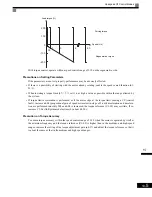
Motor Application Precautions
10-
11
Using the Drive for Special Motors
Observe the following precautions when using a special motor.
Pole-changing Motor
The rated input current of pole-changing motors differs from that of standard motors. Select, therefore, an
appropriate Drive according to the maximum input current of the motor to be used. Before changing the num-
ber of poles, always make sure that the motor has stopped. Otherwise, the overvoltage protective or overcur-
rent protective mechanism will be actuated, resulting in an error.
Submersible Motor
The rated input current of submersible motors is higher than that of standard motors. Therefore, always select
Drive by checking its rated output current. When the distance between the motor and Drive is long, use a cable
thick enough to connect the motor and Drive to prevent motor torque reduction.
Explosion-proof Motor
When an explosion-proof motor is to be used, it must be subject to an explosion-proof test in conjunction with
the Drive. This is also applicable when an existing explosion-proof motor is to be operated with the Drive.
Since the Drive itself is, however, not explosion-proof, always install it in a safe place.
Gearmotor
The speed range for continuous operation differs according to the lubrication method and motor manufacturer.
In particular, continuous operation of an oil-lubricated motor in the low speed range may result in burning. If
the motor is to be operated at a speed higher than 60 Hz, consult with the manufacturer.
Synchronous Motor
A synchronous motor is not suitable for Drive control. If a group of synchronous motors is individually turned
ON and OFF, synchronism may be lost.
Single-phase Motor
Do not use Drive for a single-phase motor. The motor should be replaced with a 3-phase motor.
Power Transmission Mechanism (Speed Reducers, Belts, and Chains)
If an oil-lubricated gearbox or speed reducer is used in the power transmission mechanism, oil lubrication will
be affected when the motor operates only in the low speed range. The power transmission mechanism will
make noise and experience problems with service life and durability if the motor is operated at a speed higher
than 60 Hz.
Summary of Contents for CIMR-G7U
Page 2: ......
Page 7: ...v...
Page 32: ...1 18...
Page 90: ...3 16...
Page 112: ...4 22...
Page 382: ...6 164...
Page 410: ...7 28...
Page 454: ......
Page 455: ......
















































